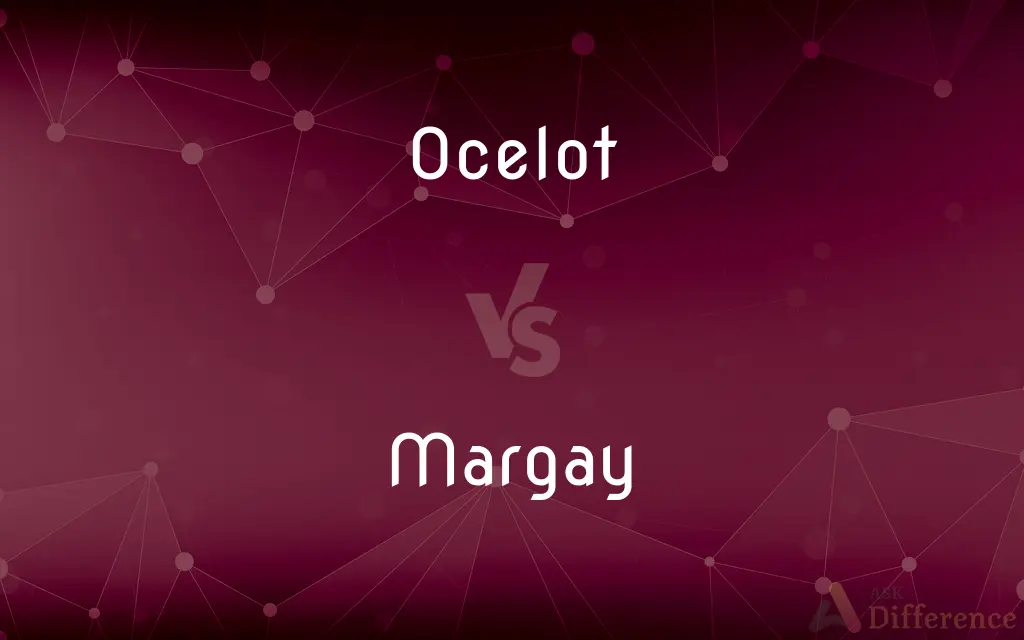Ocelot vs. Margay — What's the Difference?
Edited by Tayyaba Rehman — By Fiza Rafique — Updated on September 28, 2023
Ocelots are medium-sized wildcats found in South and Central America, while margays are smaller wildcats with exceptional tree-climbing abilities from the same regions.

Difference Between Ocelot and Margay
Table of Contents
ADVERTISEMENT
Key Differences
Ocelots and margays are both captivating wildcats native to the Americas, particularly Central and South America. The ocelot, being medium-sized, is notably larger than the margay. Both sport spotted coats, but their body size and structure exhibit discernible differences, with ocelots presenting a more robust build compared to the more delicate margay.
While ocelots predominantly reside in varied habitats ranging from rainforests to grasslands, margays show a distinct preference for dense forests due to their exceptional arboreal lifestyle. Margays are known for their impressive tree-climbing capabilities, while ocelots, though capable climbers, spend more time on the ground.
Ocelots possess short tawny or reddish-brown coats decorated with open spots, often with a dark outline. Margays, on the other hand, have longer fur, typically softer, with spots that can sometimes form rosettes, making them look a bit like miniature leopards. Both these cats have beautiful markings, but the margay's coat tends to be more vibrant.
In terms of behavior, ocelots are primarily nocturnal, hunting rodents, birds, and small mammals at night. Margays, while also nocturnal, exhibit an incredible adaptability in hunting, thanks to their rotating ankle joints. This trait allows margays to descend trees headfirst and maneuver adeptly through branches, giving them an edge in capturing tree-dwelling prey.
Comparison Chart
Size
Medium-sized
Smaller
ADVERTISEMENT
Preferred Habitat
Rainforests to grasslands
Dense forests
Coat Pattern
Short fur with open spots
Longer, softer fur with spots and sometimes rosettes
Behavior
Primarily nocturnal; ground-dweller
Nocturnal; exceptional tree-climber
Physical Adaptation
Robust build
Rotating ankle joints for adept tree navigation
Compare with Definitions
Ocelot
A nocturnal feline predator often found in varied habitats ranging from grasslands to forests.
At night, the ocelot emerges to hunt its prey with stealth.
Margay
A nocturnal feline with a longer, softer coat often decorated with rosette patterns.
The margay's fur pattern can sometimes resemble that of a leopard.
Ocelot
A wildcat known for its keen senses and agility, especially in nighttime hunting.
The ocelot's keen eyesight aids in detecting prey in low light.
Margay
A small arboreal wildcat from Central and South America known for its adept tree-climbing.
The margay's rotating ankle joints enable it to navigate trees with ease.
Ocelot
A medium-sized wildcat native to South and Central America with a tawny, spotted coat.
The ocelot's distinctive coat makes it a target for poachers.
Margay
A member of the Felidae family, highly adapted for a life among tree branches.
The margay's long tail assists with balance during its tree-bound pursuits.
Ocelot
A member of the Felidae family with a distinctive patterned appearance.
The ocelot's beautiful fur pattern aids in camouflaging in its natural habitat.
Margay
A wildcat with unique physical adaptations to hunt in dense forests.
The margay can hang onto a tree branch using just one hind foot.
Ocelot
A terrestrial cat, also known as the dwarf leopard due to its spotted appearance.
The ocelot, though sometimes called a dwarf leopard, has its own unique traits.
Margay
A species known for its agility and adaptability in capturing tree-dwelling prey.
The margay can change its hunting strategy based on the environment and prey availability.
Ocelot
The ocelot (Leopardus pardalis) is a medium-sized spotted wild cat that reaches 40–50 cm (15.7–19.7 in) at the shoulders and weighs between 8 and 15.5 kg (17.6 and 34.2 lb). It was first described by Carl Linnaeus in 1758.
Margay
The margay (Leopardus wiedii) is a small wild cat native to Central and South America. A solitary and nocturnal cat, it lives mainly in primary evergreen and deciduous forest.Until the 1990s, margays were hunted illegally for the wildlife trade, which resulted in a large population decrease.
Ocelot
A nocturnal wildcat (Leopardus pardalis) of brush and woodland from southwest North America to central South America, having a grayish or yellow coat with black spots.
Margay
A spotted Central and South American wildcat (Leopardus wiedii) resembling a small, long-tailed ocelot.
Ocelot
An American feline carnivore (Leopardus pardalis, syn. Felis pardalis) covered with blackish ocellated spots and blotches which are variously arranged.
Margay
Leopardus wiedii, a spotted cat native to Central and South America.
Ocelot
An American feline carnivore (Felis pardalis). It ranges from the Southwestern United States to Patagonia. It is covered with blackish ocellated spots and blotches, which are variously arranged. The ground color varies from reddish gray to tawny yellow.
Margay
A small American wild cat (Felis wiedi syn. Felis tigrina), ranging from Mexico to Brazil. It is spotted with black. Called also long-tailed cat.
Ocelot
Nocturnal wildcat of Central America and South America having a dark-spotted buff-brown coat
Margay
Small spotted wildcat found from Texas to Brazil
Common Curiosities
Where can ocelots be commonly found?
Ocelots inhabit a range of environments from rainforests to grasslands in Central and South America.
Which cat is more adept at climbing trees?
The margay is especially skilled at tree-climbing due to its rotating ankle joints.
Which cat is sometimes referred to as a dwarf leopard?
The ocelot is sometimes referred to as a dwarf leopard due to its spotted coat.
What kind of prey does the margay typically hunt?
Margays primarily hunt tree-dwelling animals due to their arboreal nature.
Are ocelots and margays the same?
No, ocelots are medium-sized wildcats, while margays are smaller and more adapted to tree-climbing.
Why is the margay's tree-climbing ability unique among wildcats?
Margays have rotating ankle joints that allow them to descend trees headfirst.
How do ocelots and margays primarily differ in their hunting habits?
Ocelots are primarily ground-dwellers, while margays are exceptional tree-climbers.
What's a distinctive feature of the margay's fur?
The margay's fur is longer and softer, often with rosette patterns.
Are margays endangered?
Margays face threats like habitat loss and are considered "Near Threatened" on the IUCN Red List.
What adaptations help margays in their tree-bound pursuits?
Margays have a long tail for balance and rotating ankle joints for maneuvering through trees.
How do ocelots camouflage in the wild?
Ocelots use their tawny, spotted coats to blend into their surroundings.
What size are ocelots compared to domestic cats?
Ocelots are larger than most domestic cats, being medium-sized wildcats.
Are ocelots aggressive?
Like many wild animals, ocelots can be aggressive, especially when threatened.
Are there efforts to conserve both ocelots and margays?
Yes, there are conservation efforts in place to protect both species from threats like habitat loss and poaching.
What habitats do margays prefer?
Margays have a strong preference for dense forests.
Share Your Discovery

Previous Comparison
Earth vs. Mars
Next Comparison
Grapefruit vs. OrangeAuthor Spotlight
Written by
Fiza RafiqueFiza Rafique is a skilled content writer at AskDifference.com, where she meticulously refines and enhances written pieces. Drawing from her vast editorial expertise, Fiza ensures clarity, accuracy, and precision in every article. Passionate about language, she continually seeks to elevate the quality of content for readers worldwide.
Edited by
Tayyaba RehmanTayyaba Rehman is a distinguished writer, currently serving as a primary contributor to askdifference.com. As a researcher in semantics and etymology, Tayyaba's passion for the complexity of languages and their distinctions has found a perfect home on the platform. Tayyaba delves into the intricacies of language, distinguishing between commonly confused words and phrases, thereby providing clarity for readers worldwide.















































